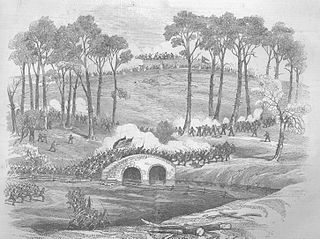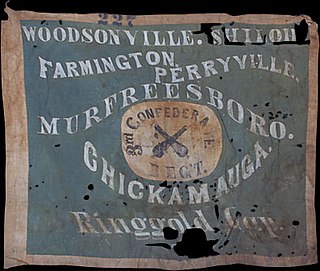
The Bermuda Hundred campaign was a series of battles fought at the town of Bermuda Hundred, outside Richmond, Virginia, during May 1864 in the American Civil War. Union Maj. Gen. Benjamin Butler, commanding the Army of the James, threatened Richmond from the east but was stopped by forces under Confederate Gen. P.G.T. Beauregard.
The 14th Indiana Infantry Regiment, later referred to as the Gallant Fourteenth, was an infantry regiment and part of the Union Army's celebrated "Gibraltar Brigade" of the Army of the Potomac during the American Civil War. Organized in May 1861 at Camp Vigo, near Terre Haute, Indiana, it was the state's first regiment organized for three years of service. The 14th Indiana served in major campaigns and battles in the Eastern Theater, mostly in West Virginia, Virginia, Pennsylvania, and Maryland. During its three years of service, the regiment had a total of 222 casualties.
The 2nd Maryland Infantry was an American military regiment in the Union Army during the American Civil War. It should not be confused with the 2nd Maryland Infantry, CSA, which was composed of Maryland volunteers who fought for the Confederacy during the war. The regiment fought at numerous battles during the course of the war, and lost 5 officers and 84 men killed and wounded, plus 3 officers and 134 men died of disease, for a total of 226 casualties.
The 12th West Virginia Infantry Regiment was an infantry regiment that served in the Union Army during the American Civil War. The regiment was particularly distinguished for its successful attack on Fort Gregg during the 1864 to 1865 Siege of Petersburg, receiving a golden eagle for its flagstaff as a token of appreciation from corps commander John Gibbon.

Alfred Gibbs was a career officer in the United States Army who served as a brigadier general in the Union Army during the American Civil War.

The Iron Brigade, also known as The Black Hats, Black Hat Brigade, Iron Brigade of the West, and originally King's Wisconsin Brigade was an infantry brigade in the Union Army of the Potomac during the American Civil War. Although it fought entirely in the Eastern Theater, it was composed of regiments from three Western states that are now within the region of the Midwest. Noted for its strong discipline, its unique uniform appearance and its tenacious fighting ability, the Iron Brigade suffered the highest percentage of casualties of any brigade in the war.

The 8th Connecticut Infantry Regiment was an infantry regiment that fought in the Union Army during the American Civil War.

The 21st Massachusetts Infantry Regiment was an infantry regiment in the Union Army during the American Civil War. It was organized in Worcester, Massachusetts and mustered into service on August 23, 1861.
The following Union Army units and commanders fought in the Battle of Fort Stevens of the American Civil War on July 11–12, 1864. The Confederate order of battle is listed separately.
The 67th Ohio Infantry Regiment was an infantry regiment in the Union Army during the American Civil War.
The 130th Ohio Infantry Regiment, sometimes 130th Ohio Volunteer Infantry was an infantry regiment in the Union Army during the American Civil War. It was originally organized as the 1st Ohio National Guard.
The 132nd Ohio Infantry Regiment, sometimes 132nd Ohio Volunteer Infantry was an infantry regiment in the Union Army during the American Civil War.
The 138th Ohio Infantry Regiment, sometimes 138th Ohio Volunteer Infantry was an infantry regiment in the Union Army during the American Civil War.
The 148th Ohio Infantry Regiment, sometimes 148th Ohio Volunteer Infantry Regiment was an infantry regiment in the Union Army during the American Civil War.

The 18th Arkansas Infantry (Marmaduke's) (1861–1865) was a Confederate Army infantry regiment during the American Civil War. The unit was also briefly identified as the 1st Arkansas Infantry Battalion. The unit was most often referred to as the 3rd Confederate Infantry Regiment. The designation "Confederate Infantry Regiment" was intended to convey the difference between Provisional Confederate Army units and Regular Confederate Army Units, with Provisional units being those regiments who received a state designation such as "XX Arkansas Infantry Regiment". In practice, the designation was most often utilized when Regiments were assembled utilizing companies from more than one Confederate state. The "3rd Confederate Infantry Regiment" is occasionally misidentified as the 3rd Arkansas Infantry Regiment commanded by Colonel Van H. Manning.
The 13th Indiana Infantry Regiment, was an infantry regiment in the Union Army during the American Civil War.

The 45th New York Infantry Regiment, also known as the 5th German Rifles, was an infantry regiment that served in the Union Army during the American Civil War. It was composed almost entirely of German immigrants. Formed approximately five months after the start of hostilities, the unit's service spanned almost the entirety of the war, and it saw action in several of the war's noteworthy battles, in both the Eastern and Western Theaters.

James Gwyn was an officer in the Union Army during the American Civil War. He immigrated at a young age from Ireland in 1846, initially working as a storekeeper in Philadelphia and later as a clerk in New York City. At the onset of the war, in 1861, he enlisted and was commissioned as a captain with the 23rd Pennsylvania Volunteer Infantry. He assumed command of the 118th Pennsylvania Regiment in the course of the war. Gwyn led that regiment through many of its 39 recorded battles, including engagements at Seven Pines, Fredericksburg, Shepherdstown, Five Forks, Gettysburg, and Appomattox Court House.
The 11th Connecticut Infantry Regiment was an infantry regiment that served in the Union Army during the American Civil War.

Arthur Henry Dutton was an American career soldier. A trained military engineer and high graduate of West Point, he served mostly as an infantry officer in the Union Army, fighting within both the Eastern Theater and Western Theaters during the American Civil War.









